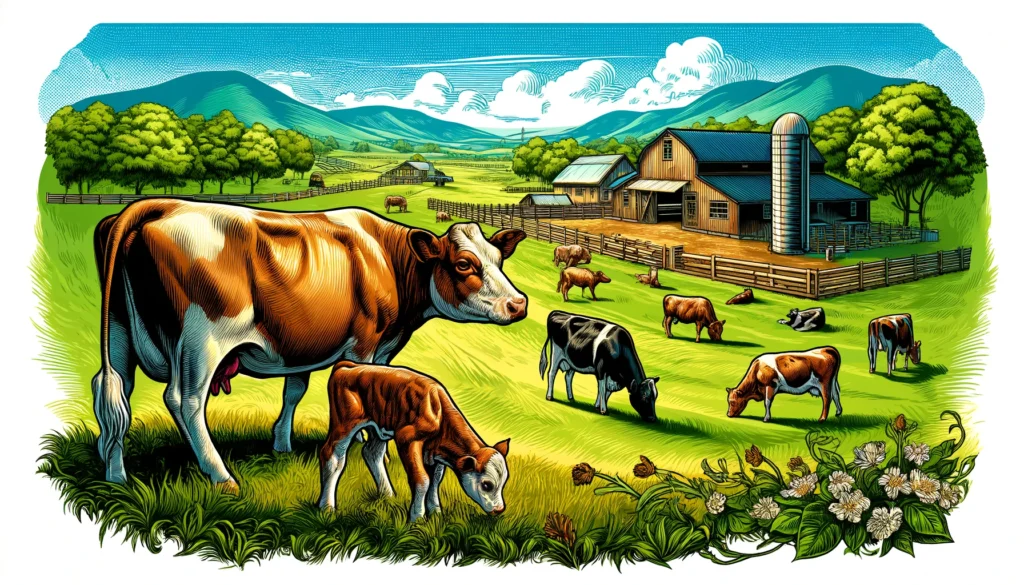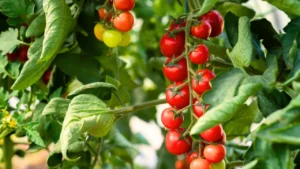
Cow Calf Operations A vivid and detailed illustration of a cow calf operation. Show beef cows and calves in a pastoral setting grazing on green pastures with rolling hil3.webp.webp
Definition: Cow-Calf Operations
Cow-Calf Operations are a type of cattle farming where a herd of cows is maintained to produce calves. The primary objective is to produce and raise healthy calves until they are weaned and ready for sale or further growth and finishing. These operations are the foundation of the beef supply chain.
Cow-Calf Operations: The Backbone of Beef Production
Cow-calf operations are a fundamental aspect of the beef industry, focusing on breeding, raising, and managing cattle to produce calves for beef production. This comprehensive guide explores the principles of cow-calf operations, their importance, strategies for effective management, and their impact on farming and the beef supply chain.
Fall off the barn roof and busted your keister? Life on the farm or ranch can be tough on the bum. Need a break? Laugh it off at FarmerCowboy.com, the #1 farm humor site. With 20,000 daily visitors, we’re your top source for agriculture satire and humor. Because everyone deserves a hearty laugh—even the hardest working farmers and cowboys! Join us and turn those long days into fun tales at FarmerCowboy.com.
Principles of Cow-Calf Operations
- Breeding Management: Selecting and managing breeding stock to ensure high fertility rates, healthy calves, and desirable genetic traits.
- Calving Management: Ensuring the health and safety of cows and calves during the calving process through proper nutrition, care, and monitoring.
- Weaning: Implementing strategies for successful weaning to minimize stress on calves and ensure their continued growth and health.
- Nutrition: Providing balanced nutrition to cows and calves to promote optimal health, growth, and reproductive performance.
- Health Management: Implementing preventive health measures, regular veterinary care, and disease management practices to maintain herd health.
Importance of Cow-Calf Operations
Economic Importance
- Foundation of Beef Supply: Cow-calf operations are the starting point for beef production, supplying calves for backgrounding, finishing, and ultimately, meat processing.
- Income Generation: These operations provide a significant source of income for many farmers and contribute to the overall economy of rural areas.
- Value Addition: By producing high-quality calves, cow-calf operations add value to the beef supply chain, enhancing profitability.
Environmental Importance
- Land Use: Cow-calf operations often utilize land that is not suitable for crop production, contributing to sustainable land use and maintaining open spaces.
- Ecosystem Services: Grazing cattle can help manage vegetation, reduce wildfire risks, and promote biodiversity by maintaining healthy grasslands.
Social Importance
- Rural Livelihoods: Cow-calf operations support the livelihoods of rural communities, providing employment and sustaining traditional farming practices.
- Food Security: By producing beef, these operations contribute to food security and provide a source of high-quality protein for consumers.
Strategies for Effective Cow-Calf Operations
Breeding Management
- Genetic Selection: Select breeding stock based on traits such as fertility, calving ease, growth rates, and meat quality to improve herd performance.
- Breeding Programs: Implement structured breeding programs, including artificial insemination and estrus synchronization, to enhance reproductive efficiency.
- Record Keeping: Maintain detailed records of breeding dates, health status, and performance metrics to inform management decisions.
Calving Management
- Calving Facilities: Provide clean, safe, and comfortable facilities for calving to minimize stress and complications for cows and calves.
- Monitoring: Regularly monitor pregnant cows for signs of labor and provide assistance if necessary to ensure successful calving.
- Post-Calving Care: Ensure that calves receive adequate colostrum shortly after birth to boost their immune systems and monitor for any health issues.
Weaning
- Gradual Weaning: Implement gradual weaning techniques to reduce stress on calves, such as fence-line weaning or two-step weaning.
- Nutrition: Provide high-quality feed and clean water to support the nutritional needs of weaned calves and promote healthy growth.
- Health Monitoring: Monitor weaned calves for signs of illness or stress and provide appropriate veterinary care as needed.
Nutrition
- Balanced Diet: Provide a balanced diet that meets the nutritional requirements of cows and calves, including energy, protein, vitamins, and minerals.
- Forage Management: Manage pastures and forage crops to ensure a consistent supply of high-quality feed throughout the year.
- Supplementation: Use nutritional supplements, such as mineral blocks or feed additives, to address specific dietary needs and support overall health.
Health Management
- Preventive Health Care: Implement vaccination programs, parasite control, and biosecurity measures to prevent diseases and maintain herd health.
- Regular Veterinary Care: Schedule regular veterinary check-ups and promptly address any health issues that arise.
- Stress Reduction: Minimize stress through proper handling techniques, adequate shelter, and maintaining stable social groups within the herd.
Practical Applications of Cow-Calf Operations
Pasture Management
Effective pasture management is crucial for providing high-quality forage and maintaining healthy cows and calves. Practices include rotational grazing, maintaining optimal stocking rates, and controlling invasive plant species.
Record Keeping and Data Analysis
Accurate record-keeping and data analysis help farmers track performance, make informed management decisions, and identify areas for improvement. Records should include breeding dates, health treatments, weaning weights, and growth rates.
Marketing Strategies
Developing effective marketing strategies helps maximize the value of calves. This can include participating in breed-specific sales, marketing directly to backgrounders or feedlots, and promoting value-added attributes such as organic or grass-fed beef.
Community and Extension Services
Engaging with local agricultural extension services and farming communities provides access to resources, education, and support for cow-calf operations. Participating in workshops, field days, and producer groups can enhance knowledge and skills.
How Cow-Calf Operations Help Farmers
- Income Stability: Cow-calf operations provide a steady source of income through the sale of calves, cull cows, and sometimes value-added products.
- Land Utilization: These operations make productive use of marginal lands that are unsuitable for crop production, optimizing land resources.
- Soil Health and Biodiversity: Grazing management practices promote soil health, improve water infiltration, and support diverse plant and animal communities.
- Market Opportunities: Farmers can capitalize on niche markets, such as organic, grass-fed, or locally produced beef, to increase profitability.
- Knowledge and Community: Participation in cow-calf operations fosters connections with agricultural communities, providing opportunities for knowledge exchange and support.
Conclusion
Cow-calf operations are a vital component of the beef production system, providing the foundation for the entire supply chain. Effective management of breeding, calving, weaning, nutrition, and health is essential for producing healthy, high-quality calves. These operations support economic stability, environmental sustainability, and social well-being in rural communities. By implementing best practices and leveraging available resources, farmers can enhance the productivity and sustainability of their cow-calf operations, contributing to a robust and resilient beef industry.

How Cow-Calf Operations Can Help Farmers
Cow-calf operations help farmers by providing income stability, optimizing land use, improving soil health and biodiversity, creating market opportunities, and fostering community connections. These benefits contribute to sustainable and profitable farming systems while supporting environmental conservation and rural livelihoods.
Originally posted 2024-05-29 04:31:03.
Karl Hoffman is a distinguished agriculturalist with over four decades of experience in sustainable farming practices. He holds a Ph.D. in Agronomy from Cornell University and has made significant contributions as a professor at Iowa State University. Hoffman’s groundbreaking research on integrated pest management and soil health has revolutionized modern agriculture. As a respected farm journalist, his column “Field Notes with Karl Hoffman” and his blog “The Modern Farmer” provide insightful, practical advice to a global audience. Hoffman’s work with the USDA and the United Nations FAO has enhanced food security worldwide. His awards include the USDA’s Distinguished Service Award and the World Food Prize, reflecting his profound impact on agriculture and sustainability.







Satire is the best way to laugh about the insanity of politics, and Bohiney News delivers every time. Head to bohiney.com now!